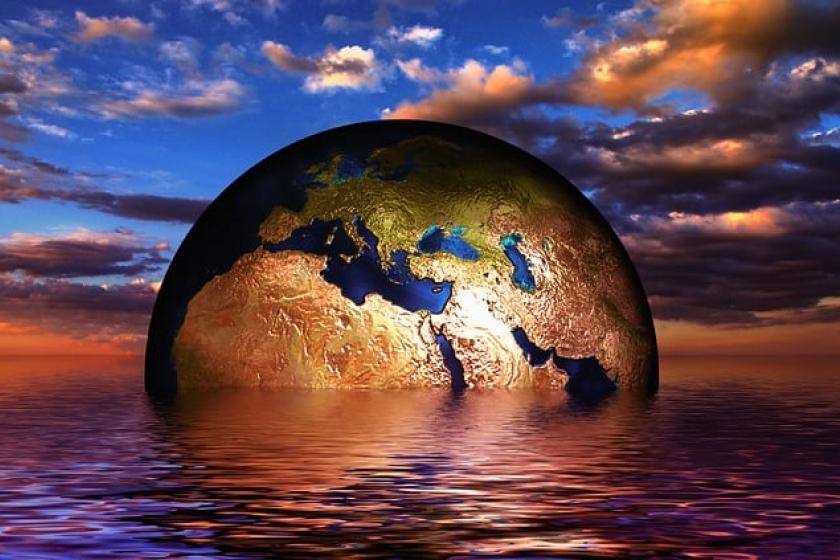Geopolitics and Climate Change Heighten Undersea Cable Concerns
Global political unrest and climate change are bringing new attention to the fragility of the undersea cable networks that carry about 95% of international digital traffic.
March 13, 2023

“The cloud is not in the sky, it is under the sea.” That was a comment from an author of a government study to assess new potential disruptions of undersea communications cables.
Roughly 95 percent of intercontinental global data traffic travels over undersea cables that run across the ocean floor. Globally, the international bandwidth used by network operators has nearly doubled from 2020 to 2022 and has now reached 3.9 Pbps, according to TeleGeography.com. The organization is known for developing submarine cable maps based on data from its Global Bandwidth Research Service.
With such volumes of traffic being carried over the network of undersea cables, increased attention is being focused on the fragility of the system. A single cable cut can bring down services of the major cloud providers, as was the case in an incident last year.
While most disruptions and cable cuts are caused by fishing or anchoring accidents, or natural disasters such as the impact of the Tonga volcano, there is growing concern about sabotage due to political unrest in Europe and the Far East. And new worries are emerging due to the impact of climate change.
On the political front, last year’s sabotage of the Nord Stream pipeline, while not a communications cable, highlighted the vulnerability of undersea systems to nefarious actors.
More recently, the potential impact of climate change has been raised. Research published in February in the journal Earth-Science Reviews by scientists from the United Kingdom’s National Oceanography Centre and the University of Central Florida found that “ocean and nearshore disturbances caused by extreme weather events have exposed hot spots along the transglobal cable network, increasing the risk of internet outages.”
The researchers noted that intensifying tropical cyclones in the northern Pacific Ocean are stressing submarine cables off the coast of Taiwan. Any outage due to such a cause would not only disrupt communications and Internet traffic, but given the charged political environment, some might rush to judgment and falsely attribute the outage to China.
Cables that traverse polar regions, which are strategically important to many nations, are also impacted by climate change. Melting glacial and sea ice “are profoundly changing ocean conditions more rapidly than many other places on Earth,” according to the researchers.
“Our analysis clearly stresses the need to carefully plan cable routes and landing station locations factoring in a range of local hazards and how those are affected by climate change,” said co-author Thomas Wahl, an associate professor in UCF’s Department of Civil, Environmental and Construction Engineering, in a release.
Other researchers have been raising the climate change impact issues for years. For example, Nicole Starosielski, an associate professor of media, culture, and communications at New York University and author of the book “The Undersea Network,” has noted that while today’s submarine cables are built and placed with greater attention to disaster risk, many cable stations, where submarine cables terminate after coming ashore, were built before climate change was a consideration in builders’ minds.
Why is that an issue? Rising seas could accelerate erosion and increase the flood risk of onshore coastal cable facilities. And in hurricane and typhoon zones, severe storms will not only attack the coast but also influence the stability of the continental shelf seabed via the formation of eroding currents and waves, according to researchers. Scientific American noted that such action could expose cables to more abrasion or suspensions above the seabed and trigger submarine landslides and greater turbidity.
Safeguard efforts on the rise
Several things are being done to minimize undersea cable outages and service disruptions.
For example, fishing and anchoring annually account for approximately 70 percent of global damage to submarine cables—far more than other human or natural causes, according to The International Cable Protection Committee (ICPC). As such, the group, which is comprised of governmental administrations and commercial companies that own or operate submarine cables, developed best practices to avoid these problems.
Suggested ways to mitigate and limit damage from fishing and anchoring include route selection and design to avoid areas of particular risk (for example, routing around designated anchorages); cable armoring; cable burial for cables installed at water depths less than 1500 meters; cable awareness and liaison programs designed to educate fishing fleets regarding the location of submarine cables, and actions to take if gear is snagged; and programs to compensate fishermen for snagged gear (so that they abandon snagged gear rather than damage cables in trying to free it).
There are also several publicly announced government efforts that try to address the increased threat due to today's turbulent political times. A 2022 report by the European Parliament on security threats to undersea communications cables and infrastructure and their consequences for the EU noted that a key aspect of cable protection is appropriate surveillance and identification of suspicious activities.
To date, cable surveillance is currently mainly provided by the industry. Some countries are doing more. Triggered by the sabotage of the Nord Stream pipeline, Briton’s Defense Secretary Ben Wallace said: “We have committed to two specialist ships with the capability to keep our cables and pipelines safe.”
Specifically, the country said it would expand its Multi-Role Ocean Surveillance Ship project. The project will now include two ships fitted with advanced sensors and carrying a number of remotely operated and autonomous undersea drones.
These recent efforts complement NATO efforts that have been underway for several years. In particular, commenting on an assessment of Russian threats to the security of undersea cables and critical infrastructure, NATO Secretary-General Jens Stoltenberg said: "I think it is important to address this because it is important to understand that most of these cables are privately owned, and it's publicly known where they are. That makes them potentially vulnerable.” As a result, NATO has reacted by doing more naval exercises and patrols at sea.
Related articles:
About the Author(s)
How to Amplify DevOps with DevSecOps
May 22, 2024Generative AI: Use Cases and Risks in 2024
May 29, 2024Smart Service Management
June 4, 2024

